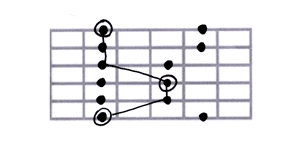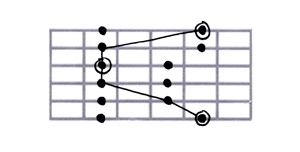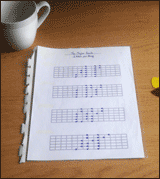
What scale should guitarists learn, is a common question. And the answer is: depends on the style of music you want to perform.
There is already a wealth of published material and guidance for classical guitarists, so in this article we’ll focus on popular music.
The minor pentatonic scale
The minor pentatonic scale is without doubt the most popular scale in the world of popular music.
Why? Because it sounds great, it’s very versatile, and it fits on the guitar neck very comfortably (two notes per string).
There are five CAGED shapes and, in my opinion, they should all be learned.
In the videos below you’ll find introductions to using all five of the minor pentatonic scale shapes over a minor chord of the same root note.
Minor pentatonic scale CAGED shape 1:
Minor pentatonic scale CAGED shape 2:
Minor pentatonic scale CAGED shape 3:
Minor pentatonic scale CAGED shape 4:
Minor pentatonic scale CAGED shape 5:
Why learn all five shapes?
The video below is part 8 in my Youtube series How to Improvise on Guitar. In it I explain why all five CAGED shapes should be learned, and I also demonstrate the benefits of knowing all five shapes in two important ways:
An introduction to the CAGED system
If you are not familiar with the CAGED system yet, watch the video below for an introduction:
If you find this video helpful do please click through and give it a thumbs up, and subscribe to my channel if you’d like more free video guitar lessons.
The major pentatonic scale
The major pentatonic scale is the major cousin of the minor pentatonic scale.
This scale appears to be identical to the minor pentatonic shapes. However, the way we use and think of the major pentatonic scale is different to how we use the minor pentatonic scale.
Depending on what chord we are playing over, the same scale pattern could be viewed as major or minor pentatonic, as shown here:

Minor pentatonic shape 1 over a minor chord

Major pentatonic shape 5 over a major chord
The minor and major blues scales
The minor blues scale and major blues scales are the same as the pentatonic scales but with an added tension note.
The blues scales are often used interchangeably with pentatonics. So, in a situation where you could use the A minor pentatonic scale, you can usually use the A minor blues scale as well.
Similarly, in a situation where you could use the major pentatonic scale, you can often use the major blues scale as well.
The major scale and its modes
The major scale is a seven-note scale, so consequently a little harder to use successfully than pentatonics.
One or two of the notes in this scale may create tension depending on the chord that is being played over. For this reason, more skill is required in improvisation.
The major scale is really a family of seven sub-scales known as ‘modes’.
Instead of playing the notes of the C major scale like this: C D E F G A B, we could play D E F G A B C.
This is known as D Dorian, the second mode of the major scale.
The resulting sound is significantly different to that produced by the C major scale in its original form.
How modes are used is a whole other area of discussion. But certainly for rock and fusion guitarists, learning the modes of the major scale is an essential skill. And, in my opinion, each mode should be learned in the five CAGED positions along the neck.
The modes can also be performed using three-notes-per-string shapes, though it probably makes more sense to learn these shapes after having learned the CAGED shapes.
Dominant pentatonic scale
The dominant pentatonic scale is contained within the fifth mode of the major scale (Mixolydian) and is just one note different from the major pentatonic scale.
I’ve decided to include this one other pentatonic here in this list, because it’s such a useful scale to use over dominant seven chords.
Dominant sevenths feature frequently in rock, blues, jazz and fusion, so there’s plenty of opportunity to use it.
If you’ve never used this scale, look it up and give it a try!
Harmonic minor scale
The harmonic minor scale sounds a little Arabic in character. However it also features heavily in classical music, and therefore neo-classical rock such as the music performed by guitarist Yngwie Malmsteen.
The harmonic minor scale also features heavily in ‘gypsy jazz’ such as the music performed by guitarist Django Reinhardt.
Like with the major scale, there are seven modes of harmonic minor. However, only the first and fifth mode, Phrygian dominant, are commonly used in western music.
As before, these scales can be learned in five positions along the neck and as three-notes-per-string shapes.
Melodic minor scale
 The melodic minor scale is another seven-note scale. Though common in classical music, jazz and fusion, melodic minor is rarely used in the pop world.
The melodic minor scale is another seven-note scale. Though common in classical music, jazz and fusion, melodic minor is rarely used in the pop world.
As with the major and harmonic minor scale, there are seven modes of melodic minor, most of which can be used in jazz and fusion.
The modes of melodic minor can be used in rock or blues. However the result is a far more sophisticated sound than many listeners might expect for these styles of music.
For this reason, the melodic minor modes may not sound authentic enough for most fans of straight-ahead rock or blues.
Whether or not you approach these styles using traditional scale choices is of course a question of taste and judgement.
Symmetrical scales
Symmetrical scales are scales that are made up of a series of repeating regular intervals.
There are two of them: the diminished scale (which has two modes) and the whole-tone scale (which has only one mode).
The character of these scales is far more ambiguous and modern sounding than the major scale, and they rarely appear outside of jazz and fusion.
A demonstration of different scales over a static chord
In the following video, part 8 of my Youtube series How to Improvise on Guitar, I demonstrate several different option for improvising over an A7 chord:
Is that it?
Well, pretty much.
We can add or remove notes to and from these scales, to create other scales; like in the case of the dominant pentatonic scale.
We also still have to learn our arpeggios of course.
But the scales listed above are the only ones that most guitarists will ever need.
A word of warning
Learning all of the scales listed here, in all their shapes, requires a great deal of time and effort. So, be sure to prioritise.
If you are just starting to learn scales, I suggest that you learn the scales in the order presented here; learn the minor pentatonics first before moving on to the major pentatonics, and so on.
Most important of all though, be sure to spend plenty of time improvising with each of these scales and shapes over suitable backing tracks or with other musicians.
Don’t be in too much of a rush to move on to another scale.
It’s easy to get drawn into learning more and more scales and shapes because it feels like we’re getting somewhere. But we mustn’t lose sight of the fact that scales are just the raw resources from which we create music.
Our priority is to be good musicians, not to memorise endless scale patterns.
It’s far better to be able to improvise well with a single minor pentatonic shape than to know a hundred different scale shapes and not be able to create good music with any of them!
See also article: Which arpeggios should guitarists learn?
If you liked this article ‘What scales should guitarists learn?’ please share it with others:
SEP
2013

About the Author:
Stuart Bahn is a professional guitarist and guitar educator in London, England.